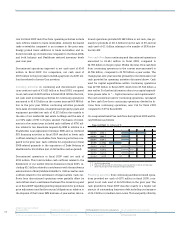Siemens 2009 Annual Report Download - page 186
Download and view the complete annual report
Please find page 186 of the 2009 Siemens annual report below. You can navigate through the pages in the report by either clicking on the pages listed below, or by using the keyword search tool below to find specific information within the annual report.
98
Reports Supervisory Board /
Managing Board Corporate Governance Management’s discussion and analysis Consolidated Financial Statements
44 Business and operating environment 63 Fiscal 2009 – Financial summary 66 Results of operations 84 Financial position
Risk report
RISK MANAGEMENT
Our risk management policy stems from a philosophy of pur-
suing sustainable growth and creating economic value while
avoiding and managing inappropriate risks. As risk manage-
ment is an integral part of how we plan and execute our busi-
ness strategies, our risk management policy is set by the Man-
aging Board. Our organizational and accountability structure
requires each of the respective management of our Sectors,
Cross-Sector Businesses, regional Clusters, Regional Compa-
nies and Corporate Units to execute risk management pro-
grams that are tailored to their specific industries and respon-
sibilities, yet consistent with the overall policy established by
the Managing Board.
We have implemented and coordinated a set of risk manage-
ment and control systems which support us in the early recog-
nition of developments jeopardizing the continuity of our
business. The most important of these systems include our
enterprise-wide processes for strategic planning and manage-
ment reporting. The former is intended to support us to con-
sider potential risks well in advance of major business deci-
sions, while the latter is intended to enable us to monitor such
risks more closely as our business progresses. Our internal au-
ditors also regularly review the adequacy and effectiveness of
our risk management system. Thereby, if deficits are detected
appropriate measures for their elimination will be adopted.
This coordination of processes and procedures is intended to
help to ensure that the Managing Board and the Supervisory
Board are fully and timely informed about significant risks, as
described in more detail in the section “Corporate Gover-
nance.”
Risk management at Siemens is based on a comprehensive,
interactive and management-oriented Enterprise Risk Man-
agement (ERM) approach that is integrated into the organiza-
tion and that addresses both risks and opportunities. The ERM
process serves for early identifying, evaluating and respond-
ing to those risks and opportunities that could materially af-
fect the achievement of our strategic, operational, financial
and compliance objectives. In order to enable a comprehensive
view on our business activities, risks and opportunities are
identified in a structured way combining elements of a top-
down and bottom-up approach. Risks and opportunities are
reported on a quarterly basis whereas the regular reporting
process is complemented by an ad-hoc reporting process to
escalate critical issues in a timely manner. All relevant risks
and opportunities are prioritized in terms of impact and likeli-
hood, considering quantitative and/or qualitative perspec-
tives. The bottom-up identification and prioritization process
is supported by workshops with the respective management at
Division, Cross-Sector Business, regional Cluster and Corporate
level. This top-down element ensures that potential new risks
and opportunities are discussed on management level and are
included in the subsequent reporting process, if found to be
applicable. Reported risks and opportunities are analyzed re-
garding potential cumulative effects and are aggregated on
Sector, Cross-Sector Business, regional Cluster and Corporate
level.
Responsibilities are assigned for all relevant risks and opportu-
nities. The hierarchical level of responsibility thereby depends
on the significance of the respective risk or opportunity. As-
suming responsibility for a specific risk or opportunity requires
to determine one of our general response strategies, or a com-
bination of them. Concerning risks, our general response
strategies are avoidance, transfer, reduction or acceptance of
the risk. With respect to opportunities, our general response
strategies are non-realization, transfer and partial or complete
realization of the opportunity. In a second step, responsibility
for a risk or opportunity also includes the development, initia-
tion and monitoring of corresponding response measures in
alignment with the chosen response strategy. These response
measures have to be specifically tailored to allow for an effec-
tive risk management. For that reason we have initiated a vari-
ety of response measures with different characteristics: For
example, we mitigate the risk of fluctuations in currency and
interest rates by engaging in hedging activities. Regarding our
long-term projects, a systematic and comprehensive project
management with standardized project milestones and clearly
























